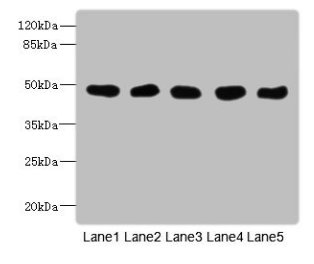
WB analysis of various sample lysates using GTX66552 GCDH antibody. Dilution : 1:1000 Loading : 25microg per lane
GCDH antibody
GTX66552
ApplicationsWestern Blot
Product group Antibodies
TargetGCDH
Overview
- SupplierGeneTex
- Product NameGCDH antibody
- Delivery Days Customer9
- Application Supplier NoteWB: 1:200 - 1:2000. *Optimal dilutions/concentrations should be determined by the researcher.Not tested in other applications.
- ApplicationsWestern Blot
- CertificationResearch Use Only
- ClonalityPolyclonal
- ConjugateUnconjugated
- Gene ID2639
- Target nameGCDH
- Target descriptionglutaryl-CoA dehydrogenase
- Target synonymsACAD5, GCD, glutaryl-CoA dehydrogenase, mitochondrial, glutaryl-Coenzyme A dehydrogenase
- HostRabbit
- IsotypeIgG
- Protein IDQ92947
- Protein NameGlutaryl-CoA dehydrogenase, mitochondrial
- Scientific DescriptionThe protein encoded by this gene belongs to the acyl-CoA dehydrogenase family. It catalyzes the oxidative decarboxylation of glutaryl-CoA to crotonyl-CoA and CO(2) in the degradative pathway of L-lysine, L-hydroxylysine, and L-tryptophan metabolism. It uses electron transfer flavoprotein as its electron acceptor. The enzyme exists in the mitochondrial matrix as a homotetramer of 45-kD subunits. Mutations in this gene result in the metabolic disorder glutaric aciduria type 1, which is also known as glutaric acidemia type I. Alternative splicing of this gene results in multiple transcript variants. A related pseudogene has been identified on chromosome 12. [provided by RefSeq, Mar 2013]
- Storage Instruction-20°C or -80°C,2°C to 8°C
- UNSPSC12352203




